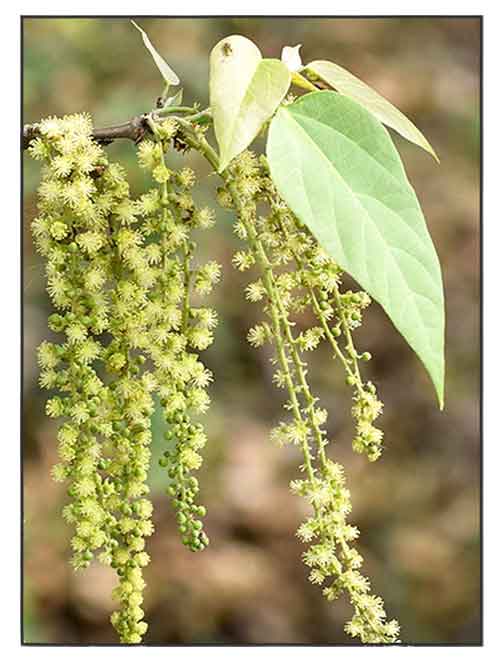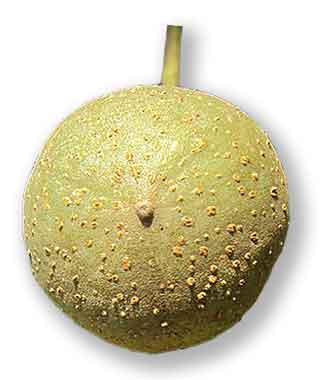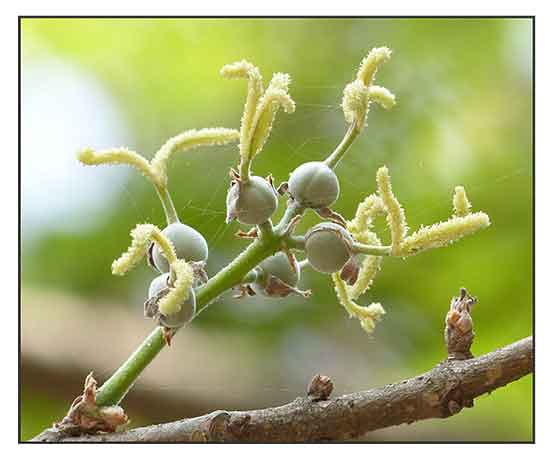 Gen info Gen info
- Mallotus is a genus of the spurge family Euphorbiaceae, first described as a genus in 1790. The genus has about 150 species of dioecious trees or shrubs. (15)
-
Mallotus nudiflorus, the false white teak, is a species of flowering plant in the family Euphorbiaceae.
- Etymology: The genus name derives from Greek word Mallotus, meaning 'a wooly or hairy thing", alluding to the plant's hairy appearance. The specific epithet nudiflorus derives from Latin words nidus meaning "naked" or "without", and florus meaning "flower", referring to the plant's unadorned flowers, lacking showy petals.
Botany
• Trees, up to 25 m tall, deciduous; branchlets tomentose or villous. Stipules lanceolate, ca. 5 mm, deciduous; petiole 5-12 cm; leaf blade ovate or oblong-ovate, 10-15 × 8-14 cm, papery, abaxially villous, adaxially pilose along veins, base cordate, rarely broadly rounded, with 2 or 4 glands, apex acuminate. Male inflorescences 6-25(-30) cm, densely villous; bracts ovate-lanceolate, ca. 3 mm. Female inflorescence 1.5-11 cm, often 1-flowered; peduncle to 3 cm, pilose. Female flowers: pedicel 1-9 mm; calyx 5-6 mm; ovary tomentulose; styles often 3, basally connate, 2-2.5 cm. Drupe globose, 2-4-locular, [1-]2-3.5 cm in diam., glabrous [or hairy]; exocarp thick and fleshy [or very thin]. Fl. Jan-Apr, fr. Jun-Dec. (Flora of China)
Distribution
- Native to the
Philippines.
- Also native to Assam, Bangladesh, Borneo, Cambodia, China South-Central, China Southeast, East Himalaya, Hainan, India, Jawa, Laos, Malaya, Myanmar, Nepal, Sri Lanka, Sumatera, Thailand, Vietnam, West Himalaya. (1)
 Constituents Constituents
- Raw methanol extract of bark yielded secondary metabolites such as alkaloids, tannins, flavonoids, phlobatannins, steroids, cardiac glycosides, and isoprenoids (terpenoids), with absence of saponin. GC-FID study revealed four bound fatty acids and four free fatty acids. EA fraction showed maximum phenolic content at 133.67 mg GAE/g. (see study below) (4)
-
Qualitative phytochemical screening of various extracts (aqueous, ethanol, acetone) of M. nudiflorus fruits revealed tannin, saponic, and phenolic compounds in all 3 extracts. Flavonoids were only present in the aqueous extracts, and terpenoids only in the ethanol and acetone extracts.
- Bioassay guided separation of extracts isolated eight 2,5-diketopiperazines (DKPs) identified as cyclo(L-Pro-L-Leu) (1), cyclo(Pro-Leu) (2), cyclo(L-trans-Hyp-L-Leu) (3), cyclo(D-trans-Hyp-D-Leu) (4), and cyclo(D-Pro-L-Phe) (5), cyclo(L-Pro-L-Phe) (6), and cyclo(D-cis-Hyp-L-Phe) (7), cyclo(L-trans-Hyp-L-Phe) (8), respectively.
(see study below) (8)
- Study of stem bark isolated two new cardenolides, trewianin (1) and trewioside (2), along with scopoletin (3) and indole-3-carboxylic acid (4).
(12)
Properties
- Studies have suggested antioxidant, cytotoxicity, antibacterial, mosquito larvicidal, antifeedant, anti-ulcerogenic properties.
Parts used
Leaves, roots, bark, fruits.
Uses
Edibility
- No report found on edibility.
 Folkloric Folkloric
- No reported folkloric medicinal use in the Philippines.
- In India and Nepal, used to relieve flatulence and for treatment of gout and rheumatic problems.
- In Indian Ayurvedic medicine, traditionally used for treatment of rheumatism, arthritis, and gastritis.
- In Odisha, India,
paste of leaves used to reduce swellings.
- Leaf paste used to cure wounds; root decoction used for stomach problems, gout, rheumatism, and flatulence. Bark and leaf paste used to reduce swellings. (10)
- Fruit pulp used for wound healing.
- In Myanmar, roots used for treatment of gout.
- In the Nuapada District of Odisha, paste of crushed bark used for dental caries.
Others
- Wood: Soft, not durable. Used for making drums and farm implements.
- Fodder: Leaves used as fodder.
- Fuel: Used as wood-fuel.
 Studies Studies
• Antioxidant / Cytotoxicity / Antibacterial / Bark: Study of evaluated raw methanol extract of bark of M. nudiflorus and fractions for therapeutic value. EA fraction showed maximum phenolic content at 133.67 mg GAE/g. Antioxidant activity by DPPH assay showed the EA extract with IC50 of 12.08 µg/ml. In brine shrimp toxicity assay, the HEX fraction showed maximum toxicity with LC50 of 0.12 µg/ml. Cell cytotoxicity was observed from CHCl3 and EA on both Vero and HeLa (human cervical cancer cell) cell line. On invitro microbial screening, DCM, CHCl3, and EA fractions showed good growth inhibition against various Gm(+) and Gm(-) bacteria by disc diffusion method. Maximum ZOI was seen with CHCl3 fraction against S. aureus at 17mm. Results of invitro experiments suggest bark extracts from M. nudiflorus have great potential for medicinal use. (see constituents above) (4)
• Larvicidal Against Mosquito Larvae Culex quinquefasciatus / Seeds and Leaves: Study evaluated the larvicidal efficacy of Mallotus nudiflorus, Swietenia mahagoni, and Aphanamixis polystachya. M. nudiflorus seed extract showed larvicidal LC50s of 24458.809, 2710.997, 1259.261, 467.143 ppm for distilled water (20000-30000 ppm), methanol (2000- 4000 ppm), 50% ethanol (500-2500 ppm) and butanol (200-1000 ppm) respectively. For leaf extracts, LC50s were 27644.562, 1371.408, 1443.832, 923.367 ppm for distilled Water (20000-40000 ppm), methanol (500-4000 ppm), 50% ethanol (500-2500 ppm) and butanol (500-1500 ppm), respectively. M. nudiflorus was most toxic in inhibiting existence of mosquito larvae suggested by LC50 and relative potency values. (7)
• HT88 / Endophytic Bacterium / Stems: Strain HT88 was isolated from fresh stems of Mallotus nudiflorus, and identified as Nocardiopsis sp. by morphological analysis and 16S rRNA sequence. Extracts of fermented HT88 showed potent antimicrobial activities. Bioassay guided separation of extracts led to eight proline (or hydroxyproline, Hyp)-containing cyclic dipeptides. (see constituents above) (8)
• Anti-Ulcerogenic / Acute Oral Toxicity / Leaves: Study evaluated the acute oral toxicity and anti-ulcerogenic activities of ethanol extract of Trewis nudiflora (EETN) in indomethacin and cold-restraint stress induced gastric ulcer models in albino rats. Acute toxicity study by OECD guidelines showed the extract to be safe at doses of 2000 mg/kbw. The EETN at doses of 200 and 400 mg/kkbw orally showed statistically significant (p<0.05) dose-dependent inhibition of gastric lesions. Results suggests anti-ulcerogenic properties that may be due to cytoprotective mechanism. (13)
• Maytansinoids / Cytotoxic / Antifeedant / Seeds: A previous study of seeds isolated six maytansinoids, including: trewiasine (1). dehydrotrewiasine (2), demethyltrewiasine (3), treflorine (4), trenudine (5), and N-methyltrenudone (6). The compounds are all cytotoxic to KB cells in vitro, and active against PS leukemia invivo, and toxic as antifeedants to a variety of insect pests. Further investigation revealed minor constituents, including 10-epitrewiasine (7), nortrewiasine (8), and colubrinol (9). (14)
Availability
- Wild-crafted.
|

![]()







